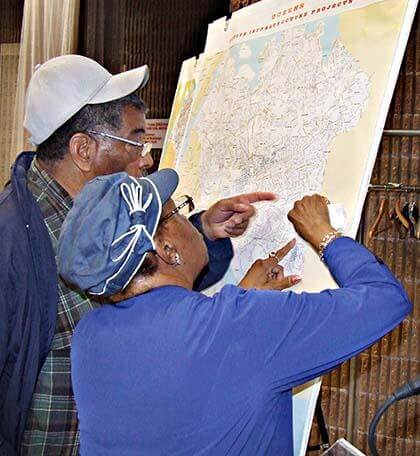By Ivan Pereira
The city Department of Environmental Protection’s plans to alleviate the flooding in southeast Queens by pumping out the excess underground water may not be happening in the near future, but officials reassured residents last week that they were working hard to prevent problems from worsening.
Administrators from the agency, along with several elected officials from the community, addressed a crowd of more than 60 people at the Robert Ross Life Family Center in St. Albans last Thursday night about the flooding that affects their streets and homes.
State Assemblyman William Scarborough (D-St. Albans), who organized the meeting along with City Councilman Leroy Comrie (D-St. Albans), said he was grateful the agency took time to listen to the concerns and update them on their projects.
“DEP has caught up with the neglect that has gone on here for years,” he said.
The biggest cause of the flooding is the high water table that exists underground, according to Scarborough. Several homes have their basements on the same level as the water table and when it rains, there is a backflow into the buildings, the assemblyman said.
“It’s very close to the surface of the ground, so that means it doesn’t take a lot of rain to flood,” he said.
Scarborough said the problem has been compounded over the years because the water pumps that would provide the community with fresh water have been shut down for nearly two decades due to pollution. The DEP has been working to create a station at 167th Street and 108th Avenue that would clean and pump the water, but it has been stalled.
DEP Deputy Commissioner Jim Roberts told the crowd the agency is committed to the station, but needs more time and planning.
Roberts said the agency is mulling the use of the Jamaica water pumps as an alternative water supply source when it repairs the upstate Delaware Aqueduct, but that is several years away.
A cost has not yet been determined for the system that would draw 67 million gallons of water per day.
“We’re committed to not pumping [out] water that’s not acceptable,” he said. “We’re in a situation where we have to balance what we spend and what we can do.”
Linda Caleb, who lives on the block where the station is being built, did not accept his explanation. Caleb, who survived pancreatic cancer, said she suffered from drinking the tainted water and she and her neighbors are suffering again with the floods.
“Nothing ever gets done and we hear the same story over and over again,” she said.
Roberts, however, did note that the agency had spent close to $1.7 billion on infrastructure work in Queens from 2002-10, including new storm sewers in Springfield Gardens, Rosedale and St. Albans. The agency also intends to spend $43 million over the next four years in southeast Queens and has plans for green projects to prevent flooding such as the blue-belt water system at Springfield and Twin Pond lakes.
“We’ve done a lot of work and there’s a lot more to do,” Roberts said.
Reach reporter Ivan Pereira by e-mail at ipereira@cnglocal.com or by phone at 718-260-4546.
Editor's note: Corrected cost.

































